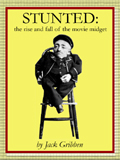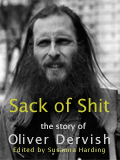 |
Stunted: The Rise and Fall of the Movie Midget
(Fishersgate Univeristy Press)
Jack Gribben
Gribben is a film theorist primarily interested in disadvantaged social groups and their place in cinema history – a field of study he terms ‘cinemarginality’. Stunted ostensibly follows the same outline as Gribben’s previous works, Celluloid Lepers and Amputees of the Silver Screen, except this time it’s about midgets. After an absurdly-lengthy definition of the term ‘midget’, Gribben provides background information on the travelling circuses that first brought unusually-shaped people into the arena of public entertainment. This, he claims, set the precedent for many of the dwarfploitation films that followed, in particular Tod Browning’s 1932 movie Freaks. Gribben compares this film with The Wizard of Oz, made a mere seven years later. In the former midgets are ultimately portrayed as vengeful murderers; in the latter they sing songs and dance around a lavish Technicolor set.
The sudden shift from vilification to patronizing acceptance, argues Gribben, was directly related to the Nazi’s rise to power in 1939 and Hollywood’s reaction against their racial ideals. Gribben also provides evidence that suggests Hitler had instructed Goebbels to film a ‘racially pure’ version of the The Wizard of Oz in which the Munchkins were to be replaced by members of the SA. Apparently Goebbels eventually shelved the idea when he realised Hitler had cast himself in the role of Dorothy.
The next milestone came in 1971 with Willy Wonka and the Choclate Factory. By this point midgets had proved they could contribute usefully to society, if only in the manufacture of novelty confectionary. However, as Gribben points out, the Oompa Loompas were by no means equal to their human counterparts. They were paid only in chocolate, had no trade union, and were forced to wear utterly ridiculous green wigs.
Nevertheless, by the 1980s vertically-challenged people were getting better parts and were no longer required to sing or dance en masse to earn their place on a movie set. In an interesting chapter entitled ‘The Seven Dwarves Syndrome’, Cribben describes how the individuality of midgets had been suppressed by the constant demand that there be hundreds of them on the screen at the same time. Terry Gilliam’s Time Bandits is notable here in that it both ironicised the midget-group dynamic and also made them the heroes.
Throughout the 80s a flurry of cheap fantasy films saw more and more height-thwarted actors landing respectable roles as dwarven thieves and mystical gnomes. Then, in 1988, a midget by the name of Warwick Davis landed the title role in the film Willow. This was a pivotal moment, argues Cribben: “Finally the little person could walk tall. The Goliath of prejudice was struck down by the sling of equality. Willow was the rock”.
However, this victory was shortlived. During the 90s there was less and less demand for midgets in films, as the vogue for sword and sorcery flicks had passed. Cribben describes this decline with great pathos, recounting how many of the big-name midget actors gave in to drink and pantomime. When the fantasy genre was eventually revived by The Lord of Rings trilogy – the perfect vehicle for a midget renaissance – all the hobbit parts were given to handsome young boys. Likewise, Tim Burton’s Charlie and the Chocolate Factory used the same actor to play all the Oompa Loompas, thus robbing the midget acting community of hundreds of jobs. Cribben’s conclusion suggests that midgets are the victims of their own success. Once they gained a certain degree of acceptance, political correctness dictated that midgets should no longer be given patronising parts to play. At the same time, however, no film director ever chose to cast a midget in any other role.
|
|







|



